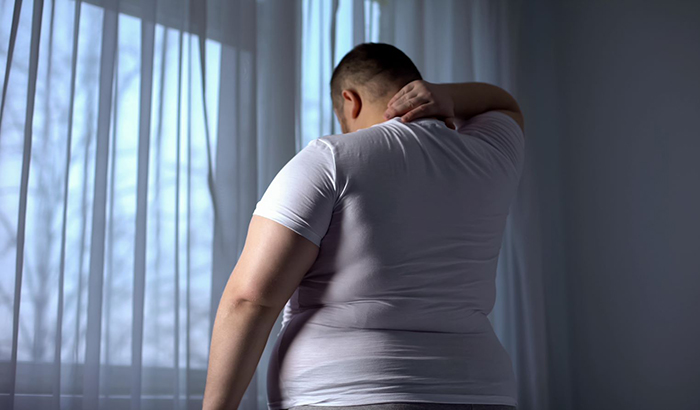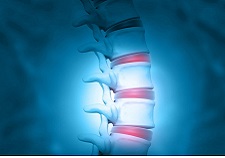Office of Research & Development |
 |


Past research found that of some 46,000 overweight Veterans surveyed, 72% reported painful conditions. (Photo: ©iStock/Motortion)
March 31, 2020
Tristan Horrom
VA Research Communications
"Pain, osteoarthritis, and weight share a complicated relationship."
Patients with higher body weight were more likely to experience pain, in a study of nearly 2 million Veterans with musculoskeletal disorders. The relationship between body weight and pain was especially pronounced in patients with osteoarthritis.
The study was one of the largest to date looking at the connection between body weight and pain specifically in a population with musculoskeletal disorders. It is the largest such study focusing on Veterans.
The results appeared March 18 in the journal Pain Medicine.

VA opens new research center to seek novel arthritis treatments

Injectable gel could help treat degenerative back pain

Blood pressure drug could prevent posttraumatic headaches

Virtual reality technology helps Veterans in pain
“Pain, osteoarthritis, and weight share a complicated relationship,” explains study author Dr. Diana Higgins, a researcher with the VA Boston Healthcare System and Boston University School of Medicine. “Overall, the more weight a patient with a musculoskeletal disorder carries, the more likely they are to report experiencing pain, which may affect functioning and quality of life.”
Previous research has shown a link between higher body mass index (BMI) and an increased risk of chronic pain. Studies have also shown a relationship between weight and musculoskeletal disorders, particularly osteoarthritis. However, the connection between these disorders, weight, and pain together is less well-known. Most studies examining the relationship between BMI and pain intensity do so among patients with existing chronic pain conditions rather than in disorders that may or may not have accompanying pain, explain the researchers.
To that end, researchers from several different VA health care systems examined data on nearly 2 million Veterans with musculoskeletal disorders. Conditions included non-traumatic joint disorder; osteoarthritis; and low back, back, and neck pain.
According to Higgins, the nature of the VA health care system provides researchers with a wealth of data to conduct large studies such as this one. “Because it is an integrated health system serving a large number of patients,” she says, “VA offers a unique opportunity to conduct these large health services research studies.”
About 79% of the study sample were overweight or obese, and 42% of the whole group said they did not have any pain.
The higher a patient’s BMI, the more likely they were to report pain. Compared to patients with normal weight, patients classified as having moderate obesity (BMI of 35 to 39.9) were 9% more likely to report pain. Patients with severe obesity (BMI of 40 or higher) had 23% higher odds of pain.
This trend was the most obvious in patients with osteoarthritis. For the osteoarthritis group, 40% of overweight patients and 55% of patients with severe obesity reported pain. The relationship between weight and pain was less pronounced in patients with back or low back pain.

Dr. Diana Higgins, with the VA Boston Healthcare System and Boston University School of Medicine, led a study on the relationship between body weight and pain. (Photo by Derrick Morin)
While the results show a link between weight and pain in osteoarthritis patients, more study is needed to understand this relationship, say the researchers. It could be that higher weight puts strain on the joints and leads to arthritis pain. But the relationship might also go the other way. Pain caused by osteoarthritis could cause patients to avoid physical activity, which could lead to a higher BMI.
Although the pain/BMI link was more prominent in patients with osteoarthritis, this group was also more likely than patients with other musculoskeletal disorders to report no pain. The researchers offered a few possible explanations for this finding. Pain is often assessed while a patient is sitting, so patients may not be bearing weight on their arthritis-afflicted joints while rating pain. Osteoarthritis pain can also vary considerably day to day, so how a patient rates their pain could depend on when they are asked.
Obesity and chronic pain are of considerable concern to the Veteran population. Chronic pain is more prevalent in Veterans than in the general population. Veterans also have higher rates of overweight and obesity than civilians. A 2016 study by the same VA researchers found that, out of about 46,000 overweight Veterans surveyed, 72% reported painful conditions. Those in the 2016 study with higher BMI were more likely to have pain.
Higgins point out that VA has made considerable efforts to address chronic pain and obesity in Veterans separately, but that little guidance exists when the conditions co-occur. She recommends finding ways to treat both together rather than each condition separately.
VA Research Currents archives || Sign up for VA Research updates